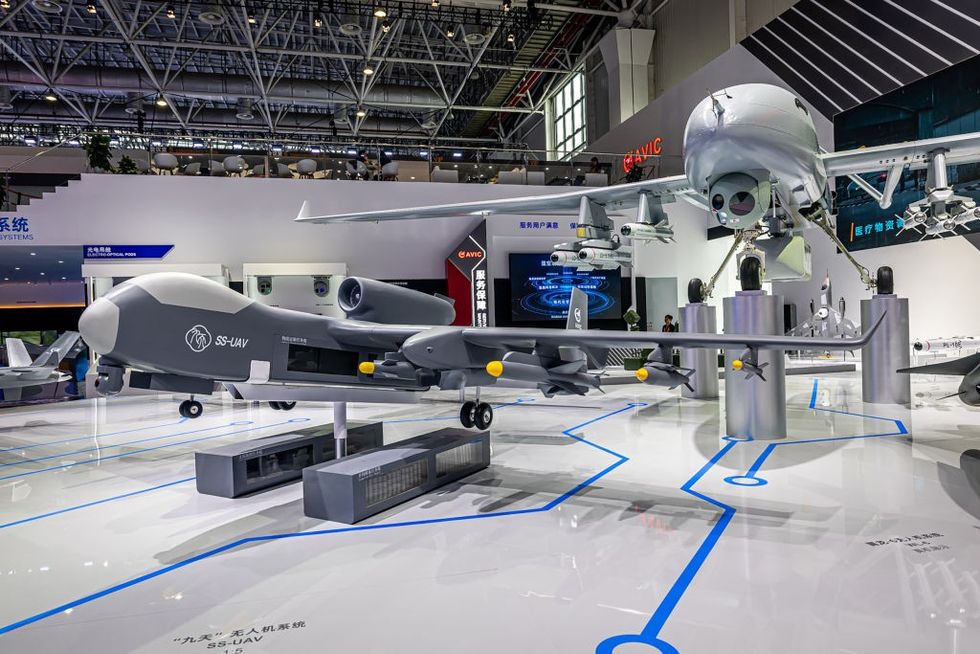State media in China post regular reports on the country’s progress in this domain: most recently, a “micro drone” that looks like a thermos and weighs less than two pounds; and the imminent deployment of what China claims will be the world’s largest drone carrier. It’s all part of what China’s PLA Daily, the official newspaper of China’s Army, recently called a “phased leap” in unmanned combat technology. The paper said the drone innovations would be “vital for defining future battlefield rules and gaining an early edge in intelligent warfare”.
That leap is being powered by sheer manufacturing capacity – China already produces some 70% of the world’s commercial drones – and a rapidly growing artificial intelligence industry.
“They have the production, they have large inventory and now they also have the AI,” Dr. Michael Raska, a professor at the Military Transformation Programme at Singapore’s S. Rajaratnam School of International Studies, told The Cipher Brief. “With all these combined, they have been experiencing a leap forward in the quality and quantity of all the drones across the different domains.”
Raska and others note that the “leap” has included a successful transition from imitating American products to innovating drone technologies of its own.
“China has long been interested in drones, and for a long time, they’ve sort of been copying the United States,” Stacie Pettyjohn, Director of the Defense Program at the Center for a New American Security, told The Cipher Brief. “They had produced knockoffs of the Predator and Reaper drones. But now they have been making advances of their own, in a number of different areas.”
Experts say it’s a “leap” driven by three global factors: lessons learned from the war in Ukraine; an increasingly intense military competition with the U.S.; and preparations for a possible conflict with Taiwan.
“Everything is sort of aimed at regaining control over Taiwan,” Raska said. “And if I think about a potential invasion of Taiwan by the PLA, I would argue a lot of it will be driven by unmanned systems.”
Inside China’s drone “leap”
The evidence of China’s drone boom isn’t hard to find; it features regularly in China’s state media.
Those micro drones were seen recently on CCTV, China’s main state television network. As the name suggests, these are small, light and relatively inexpensive weapons, and they can operate silently and carry as many as three grenades – up to twice their own weight. Experts say the PLA is integrating these drones in its infantry units – a lesson that may have been drawn from the war in Ukraine, where drones have become a regular feature of frontline warfare.
China’s media has also reported on the Jiu Tian drone carrier – the “drone mothership” – which was first introduced in November at the international Zhuhai Air Show, China’s biggest aerospace trade show. One report suggested it will be deployed at the end of this month.
 ZHUHAI, CHINA – NOVEMBER 11: A model of the Jiutian SS-UAV, a fifth-generation heavyweight unmanned aerial vehicle, is on display at the Zhuhai International Air Show Center ahead of the Airshow China 2024 on November 11, 2024 in Zhuhai, Guangdong Province of China. The 15th China International Aviation and Aerospace Exhibition, also known as Airshow China, will be held in Zhuhai from November 12 to November 17. (Photo by Chen Xiao/VCG via Getty Images)
ZHUHAI, CHINA – NOVEMBER 11: A model of the Jiutian SS-UAV, a fifth-generation heavyweight unmanned aerial vehicle, is on display at the Zhuhai International Air Show Center ahead of the Airshow China 2024 on November 11, 2024 in Zhuhai, Guangdong Province of China. The 15th China International Aviation and Aerospace Exhibition, also known as Airshow China, will be held in Zhuhai from November 12 to November 17. (Photo by Chen Xiao/VCG via Getty Images)
Billed as the world’s largest drone carrier, the Jiu Tian is an 11-ton aircraft that is itself a drone – as in, an uncrewed aerial vehicle – albeit an enormous one. According to a report published in the South China Morning Post, the Jiu Tian can hold as many as 100 smaller UAVs and carry them for more than 4,000 miles, essentially providing a delivery system for smaller drones that can only travel a fraction of that system.
That “mothership” is also capable of launching so-called kamikaze drones — weapons designed to wait until their target is found, then intercept and crash into them. And it is designed to launch swarms of drones in attacks that would pose problems for even sophisticated air defense systems.
“The big thing that really keeps me up at night is swarms,” Col. Andrew Konicki, the head of the U.S. Marine Corps Systems Command’s ground-based air defense, told a military forum in April. He was speaking about the general threat of drone swarms, from anywhere, but these weapons feature prominently in China’s “leap.”
The U.S. DoD report found that Beijing is prioritizing the development of AI-enabled technologies for all of its autonomous vehicles – what Dr. Raska refers to as the “AI Wave” in China’s military.
“The AI wave in China is driving a revolution of military affairs,” he said, “and it provides a really serious, extraordinary defense transformation” in terms of drone weapons.
Sign up for The Cipher Brief’s Nightcap newsletter: the best way to unwind every day while still staying up to speed on national security.Sign up today.
The counter-drone boom
Ukraine’s “Operation Spider Web” attacks against Russia – in which Ukraine was able to deliver small and relatively cheap drone weapons across long distances, to such devastating effect – were the latest reminder of the fact that in any future conflict, drone defenses will matter just as much as the offensive capabilities. One lesson of “Spider Web” is clear: traditional air defense systems won’t necessarily work against a sophisticated drone swarm – or even a few cheap quadcopter drones launched from a truck near a military base (as was the case in Sunday’s operation). And even if they do work — it makes little sense to take out a thousand-dollar drone with a $3 million Patriot missile.
Here too, China is by many accounts taking a “leap” forward – via a major counter-drone effort that blends electronic warfare, directed-energy weapons, and AI-driven interception systems.
Defense One reported that during a training exercise last summer, the PLA war-gamed counter-drone measures that neutralized only 40 percent of incoming UAVs – a result that prompted Chinese military planners to redouble their efforts in the counter-drone space.
“The Chinese are investing in layered defenses,” Pettyjohn said. “They’ve realized that they need multiple different types of defenses to defeat the different types of drones and to be able to deal with larger threats where multiple drones are coming at them at one time and eventually potentially swarms.”
Buoyed by government investment, China now has more than 3,000 manufacturers producing anti-drone equipment. In 2024, Beijing issued 205 procurement notices related to counter-drone technology; the figure was 122 in 2023, and only 87 in 2022.
Chinese military commentators say the country’s counter-drone innovations include radars and electro-optical sensors to detect incoming drone weapons; electronic warfare to jam them; and artificial intelligence to synthesize information into real-time threat analysis. All of this is aimed at identifying and stopping drone weapons before they do their damage.
China’s military recently conducted a series of counter-drone exercises, and a Guangzhou-based AI consultant who observed the drills told Defense One they were a success. “Wireless drones excelled in agility and response time, while fiber-guided systems – dubbed ‘hi-tech kites’ – were unmatched in anti-jamming reliability,” the consultant, Zhang Xiangbo, told Defense One. The Russians could have used any and all of these counter-drone technologies on Sunday.
Join us in Sea Island, Georgia for The Cipher Brief’s 2025 Threat Conference from October 19-22. See how you can save your seat at tcbconference.com
Where the U.S. stands
When the DoD issued its most recent report on China’s advances on the drone front, a senior defense official said that the PLA was “definitely continuing to improve their capabilities,” and that “the PLA plans to use AI and machine learning to enhance” its various drone technologies. The report also referenced regular civil-military collaborations in China, noting that the PLA and other Chinese defense organizations have hosted AI competitions and “used public purchasing platforms” to increase military access to civilian research and technologies.
“[Chinese Communist Party] leaders believe AI and machine learning will enhance information, surveillance, and reconnaissance capabilities and enable a range of new defense applications, including autonomous and precision-strike weapons,” the DoD report said.
That collaboration between China’s civilian and military manufacturing sectors is clearly helping in its drone innovation. In China, such collaborations between state enterprises and private tech firms are the norm, and such partnerships—what Dr. Raska calls a “civil-military fusion” in China – mean that China can sprint to innovation in these areas, while the U.S. and other western nations typically move at a slower pace.
All that said, the DoD report concluded that the U.S. still held an edge in the drone weapon domain. And the Pentagon has said it plans to field thousands of drones next year in its Replicator program, as part of an effort to counter China’s military build up in the Indo-Pacific. “We would not assess that they [the PLA] have caught up with or surpassed the U.S. Air Force” as yet.
Pettyjohn says the U.S.-China competition in the drone space is “a complicated thing to assess,” but she believes the U.S. risks falling behind in several areas.
“In many respects, the U.S. is behind,” she said. “If you look at the highest-end drones, what the U.S. has typically focused on, like the Reapers or the Global Hawks, I would say U.S. technology is superior. But China is probably building more. We don’t have exact numbers, but we know that they have invested in lots of them.”
She believes that at the lower end, which includes the shorter-range kamikaze drones, China has moved ahead of the United States.
In many of these areas, Pettyjohn and others say the chief U.S. problem is the slow road from innovation to battlefield use.
“We’ve been slow,” Pettyjohn said. “We like to study the problem, and our procurement process takes years to actually deliver things to warfighters.”
Dr. Raska gives the U.S. the advantage for now, but he also said that any American edge is shrinking, and that “the Chinese are pouring far more resources and manpower into the effort.”
Read more expert-driven national security insights, perspective and analysis in The Cipher Brief


